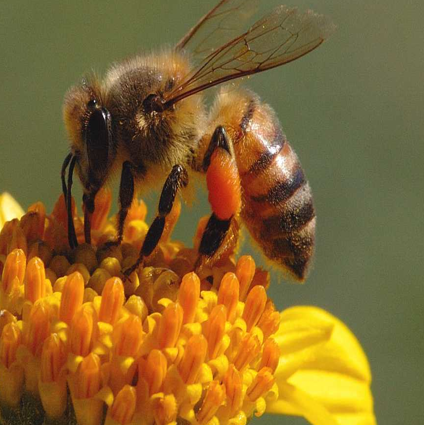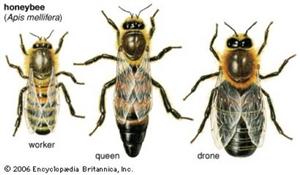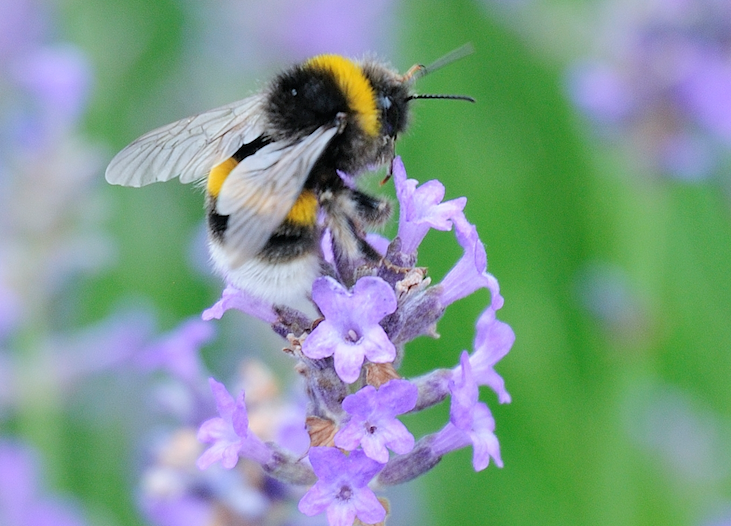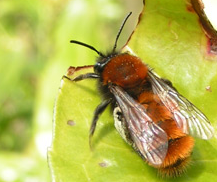There are around 30,000 named species of bees. Most are solitary: each female bee makes her own nest, lays a single egg and provides food for the single larva that develops. A few species show a high level of social development and live together in a permanent, large colony, headed by a single egg-laying queen. Although many species of bees collect nectar that they convert to honey and store as a food source, it is only these large colonies formed by social species that store appreciable quantities of honey. These bees belong to the genus Apis, known as honey bees, and others are the stingless bees, belonging to the genera Trigona and Melipona. These species have been exploited by man for thousands of years: until recent centuries, honey was the most common sweetening commodity.
The honey bees most widely used for beekeeping are European races of Apis mellifera, a species of honeybee also indigenous to Africa and the Middle East. Honey bees do not occur naturally in the Americas, Australia, New Zealand or Pacific islands: European bees have been introduced to these regions during the last four centuries. Over the last 30 years, European bees have been introduced to most countries of Asia. In industrialised countries, all beekeeping technology has been developed for use with European honey bees, and most beekeeping and research literature relate only to this bee.










The most important bee species are honey bees, bumblebees and solitary bees.
HONEY BEES
The honeybee is a medium sized bee that lives in social colonies. All honeybees are social and cooperative insects. A hive's inhabitants are generally divided into three types.
The colony contains a single fertile female (the queen), 5-50,000 sterile females or worker bees and a few hundred male bees or drones. The queen spends most of her life inside the hive, only venturing out for mating flights at the beginning of her adult life and later if she leaves the hive with a swarm to found a new colony.
Worker bees construct the wax combs used for raising the larvae and storing pollen and honey. They also feed the larvae, protect the hive from intruders, and gather nectar and pollen. Male honeybees have broader bodies than the workers and much larger eyes. The honeybee is brownish black in colour and can vary in the amount of brown banding on the abdominal segments.

Types of honey bees:

The CARNIOLAN HONEY BEE:










BUMBLEBEES
Bumblebees (Bombus species) are social insects which form colonies with a single queen. Colonies are smaller than those of honeybees, growing to as few as 50 individuals in a nest. Female bumblebees can sting repeatedly, but generally ignore humans and other animals.
Bumblebees have round bodies covered in soft hair of various colours, making them appear and feel fuzzy. Depending on the species, bumblebees may be buff coloured, black with orange-red hairs on the rear end of the abdomen, or black with yellow or yellow and white bands. Male bumblebees may differ in colour from females of the same species.
Like their relatives the honeybees, bumblebees feed on nectar, using their long hairy tongues to lap up the liquid. Bumblebees are important agricultural pollinators, so their decline in Europe is a cause for concern. The decline has been caused by habitat loss, the mechanisation of agriculture, and pesticides.
A nest in late summer will contain the old queen bee that founded the colony, and young queens that will mate, overwinter by burrowing in the soil and establish next year’s colonies. Queen bees are fertile females. Worker bees are sterile females and are smaller than queens. The role of the workers is to gather nectar and pollen to feed the grubs, which are reared in wax cells in the nest. The workers also maintain and enlarge the nest initiated by the founding queen and defend it against intruders. Male bumblebees and next year’s queens are produced in late summer. Bumblebee nests vary in size depending on the species and time of year. A well-established nest may contain up to 400 bees. Honeybee hives typically contain 50,000 bees so bumblebee nests are very small in comparison.

(Bumblebee picture taken by Nathan from Belgium)
Bumblebees by Žan D., Slovenia:











SOLITARY BEES
Solitary bees (Hymenoptera) are difficult to describe as there are many species that vary widely in their appearance. Some resemble small honeybees, others small bumblebees, while others could be mistaken for small wasps. Solitary bees differ from honeybees and bumblebees in not being social insects. They are so named because, unlike honeybees and bumblebees, they do not live in colonies. A female solitary bee constructs and provisions her nest without the assistance of any worker bees. Despite this some solitary bees can be gregarious, with many bees making their nests in close proximity in a suitable piece of habitat.

A solitary sand bee making a nest:
WILD BEES of SLOVENIA: